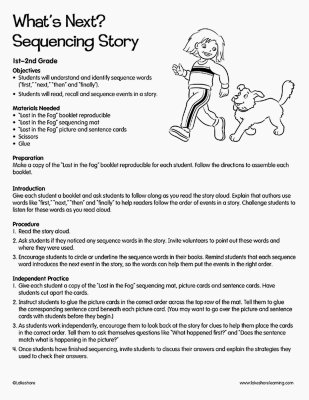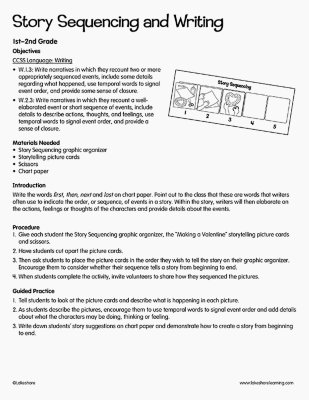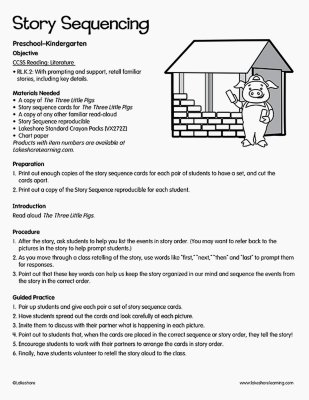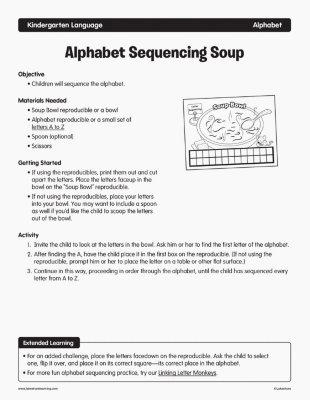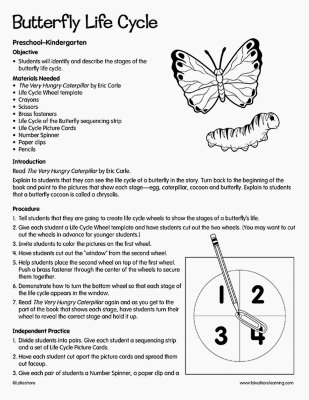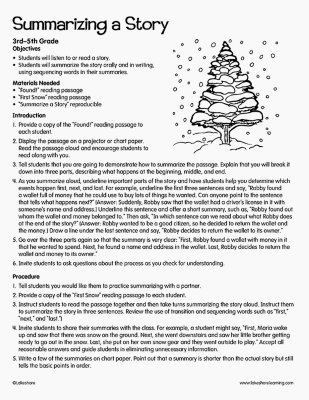Narrow by Grade
Grade
6 results for "sequencing"
What’s Next? Sequencing Story
1st Grade - 2nd Grade
Objectives Reading Literature Retelling stories and demonstrating understanding of the central message or lesson Describing characters, settings, and major events in a story, using key details Understanding and identifying sequence words (e.g., “first,” “next,” “then,” “finally”) Materials Needed Lost in the Fog booklet reproducible Lost in the Fog sequencing mat Lost in the Fog picture and sentence cards Best-Buy Scissors Lakeshore Glue Sticks Pencils Preparation Make a copy of the Lost in the Fog booklet reproducible, sequencing mat, picture cards and sentence cards for each student. Follow the directions to assemble each booklet. Introduction Give each student a booklet and ask students to follow along as you read the story aloud. Explain that authors use words like “first,” “next,” “then” and “finally” to help readers follow the order of events in a story. Challenge students to listen for these words as you read aloud.
View Lesson PlanStory Sequencing and Writing
1st Grade - 2nd Grade
Objectives CCSS Language: Writing W.1.3: Write narratives in which they recount two or more appropriately sequenced events, include some details regarding what happened, use temporal words to signal event order, and provide some sense of closure. W.2.3: Write narratives in which they recount a well-elaborated event or short sequence of events, include details to describe actions, thoughts, and feelings, use temporal words to signal event order, and provide a sense of closure. Materials Needed Story Sequencing graphic organizer Storytelling picture cards Scissors Chart paper Introduction Write the words first, then, next and last on chart paper. Point out to the class that these are words that writers often use to indicate the order, or sequence, of events in a story. Within the story, writers will then elaborate on the actions, feelings or thoughts of the characters and provide details about the events.
View Lesson PlanStory Sequencing
Pre-K
Objective CCSS Reading: Literature RL.K.2: With prompting and support, retell familiar stories, including key details. Materials Needed A copy of The Three Little Pigs Story sequence cards for The Three Little Pigs A copy of any other familiar read-aloud Story Sequence reproducible Lakeshore Standard Crayon Packs Chart paper Introduction Read aloud The Three Little Pigs.
View Lesson PlanButterfly Life Cycle
Pre-K
Objective Students will identify and describe the stages of the butterfly life cycle. Materials Needed The Very Hungry Caterpillar by Eric Carle Life Cycle Wheel template Crayons Scissors Brass fasteners Life Cycle of the Butterfly sequencing strip Life Cycle Picture Cards Number Spinner Paper clips Pencils Introduction Read The Very Hungry Caterpillar by Eric Carle. Explain to students that they can see the life cycle of a butterfly in the story. Turn back to the beginning of the book and point to the pictures that show each stage—egg, caterpillar, cocoon and butterfly. Explain to students that a butterfly cocoon is called a chrysalis.
View Lesson PlanSummarizing a Story
4th Grade
Objectives Students will listen to or read a story. Students will summarize the story in writing, using sequencing words in their summaries. Materials Needed “Found!” reading passage “First Snow” reading passage “Summarize a Story” reproducible Introduction Provide a copy of the “Found!” reading passage to each student. Display the passage on a projector or chart paper. Read the passage aloud and encourage students to read along with you. Tell students that you are going to demonstrate how to summarize the passage. Explain that you will break it down into three parts, describing what happens at the beginning, middle, and end. As you summarize aloud, underline important parts of the story and have students help you determine which events happen first, next, and last. For example, underline the first three sentences and say, “Robby found a wallet full of money that he could use to buy lots of things he wanted. Can anyone point to the sentence that tells what happens next?” (Answer: Suddenly, Robby saw that the wallet had a driver’s license in it with someone’s name and address.) Underline this sentence and offer a short summary, such as, “Robby found out whom the wallet and money belonged to.” Then ask, “In which sentence can we read about what Robby does at the end of the story?” (Answer: Robby wanted to be a good citizen, so he decided to return the wallet and the money.) Draw a line under the last sentence and say, “Robby decides to return the wallet to its owner.” Go over the three parts again so that the summary is very clear: “First, Robby found a wallet with money in it that he wanted to spend. Next, he found a name and address in the wallet. Last, Robby decides to return the wallet and money to its owner.” Invite students to ask questions about the process as you check for understanding.
View Lesson Plan